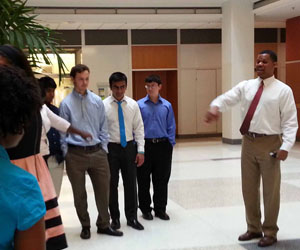This is a guest post written by Richard Watkins, the director of Sigma Xi’s Southeastern Region.

As the beneficiary of goodwill from my scientific mentors, I maintain a passion for increasing diversity in science and serving as a role model for future generations of scientific leaders. To this point, I owe my presence in the scientific community to those minority scientists who took me under their wing and introduced me to the broader scientific community. Now that I am advancing my own career, it seems natural for me to give back.
 On several occasions while attending scientific conferences, I’ve been approached by aspiring minority scientists who unexpectedly thanked me. When I ask why they are thanking me, they respond by saying that seeing me—a young black researcher—reassures them that they too can become a scientist. Although this is personally fulfilling, I believe there is much more work to be done to improve minority participation in science, technology, engineering and mathematics (STEM) fields.
On several occasions while attending scientific conferences, I’ve been approached by aspiring minority scientists who unexpectedly thanked me. When I ask why they are thanking me, they respond by saying that seeing me—a young black researcher—reassures them that they too can become a scientist. Although this is personally fulfilling, I believe there is much more work to be done to improve minority participation in science, technology, engineering and mathematics (STEM) fields.
Historically, white men have dominated the scientific enterprise, but over the past several decades, many initiatives have been undertaken to increase diversity in science. Despite major initiatives designed to address the disparity, it has been difficult to determine whether the state of diversity in science has improved. To evaluate the progress toward this goal, several organizations have collected data regarding diversity in science, most notably is the U.S. Census.
The 2010 U.S. Census data paints a very sobering picture of the lack of gender diversity in science. Women represent over 47.5% of the residential population of the U.S., but represent only 25.8% of the STEM workforce. These statistics are for the most part reversed for STEM-related occupations, a classification from the U.S. Census that includes jobs such as medical and health services managers, registered nurses, and dental hygienists. STEM-related occupations are held predominately by women (26% to 74% men to women respectively). It is well-known that systemic barriers prevent women from STEM careers (National Survey Conducted by AAAS and Science Confirms Continuing Obstacles to Women in Science, Ginger Pinholster, September 28, 2010); however defining and eliminating those barriers has proven difficult. As a result, men represent 61% of all science and engineering graduates, whereas women only represent 39%.
Gender is not the only area of diversity in which the scientific community struggles to achieve balance; race is another glaring problem. According to the U.S. Census data, non-Hispanic whites and Asians are overrepresented in STEM occupations. While over 70% percent of the U.S. STEM workforce is composed of whites, less than 14% is black or Hispanic. Hispanics represent 14.9% of the total workforce but only 6.5% of the STEM workforce. Similarly, blacks represent 10.8% of the overall workforce but only 6.4% of the STEM workforce.
It is not clear why the representation of blacks and Hispanics in the STEM workforce fails to reflect their representation in the general workforce. The problem appears to manifest as a result of their underrepresentation in STEM degree programs. Blacks only represent 7.1% of those with bachelor degrees in science. Similarly Hispanics represent 6.8% of those with bachelor degrees in a science or engineering field. Therefore it seems there is a need to recruit at an early age and provide support as these students progress through STEM programs.
Recruiting minorities into the STEM workforce is about more than equal representation. Given that the median income for STEM occupations is consistently higher than the median income for U.S. workers, minority groups are missing out on an opportunity to address economic disparity. According to the U.S. Census data, the median income for black families is $20,000 less per year than the American median income. However, a woman who receives a bachelor’s degree in science and goes into the STEM workforce on average earns $75,000 annually, whereas the average annual income of the total workforce is $58,800. That’s a difference of $16,200. Therefore, a career in science becomes a means toward economic stability and progression. This is essential for the empowerment of economically disadvantaged groups. Thus it is paramount that all groups are initially given fair and equitable access to programs that develop proficiencies in science and technology and, ultimately, pathways to STEM careers.
The Chancellor’s Science Scholars Program at the University of North Carolina at Chapel Hill provides a pathway to success for highly able students who aspire to become leading PhD and MD/PhD scientists in our increasingly interdisciplinary world. Aiming to increase the diversity among future science leaders, CSS is modeled after the nationally recognized Meyerhoff Scholars Program at the University of Maryland-Baltimore County. The Chancellor’s Science Scholars Program provides a head start and continuous support for superb students, allowing them to succeed in math and science at the highest level (http://chancellorssciencescholars.web.unc.edu).
As the program coordinator for the Chancellor’s Scholars Program, I focus on preparing students for success in graduate school and beyond. Together with similar programs implemented at other institutions, we are working to cultivate and groom the world’s best talent. With an emphasis on diversity, the Chancellor’s Science Scholars Program is part of the University of North Carolina’s larger commitment to diversity in STEM (http://www.unc.edu/spotlight/diversity-in-stem/).
Richard Watkins is the program coordinator of the Chancellor’s Science Scholars Program at the University of North Carolina at Chapel Hill.
Photo caption: The author with students in the University of North Carolina at Chapel Hill's Chancellor's Science Scholars Program.